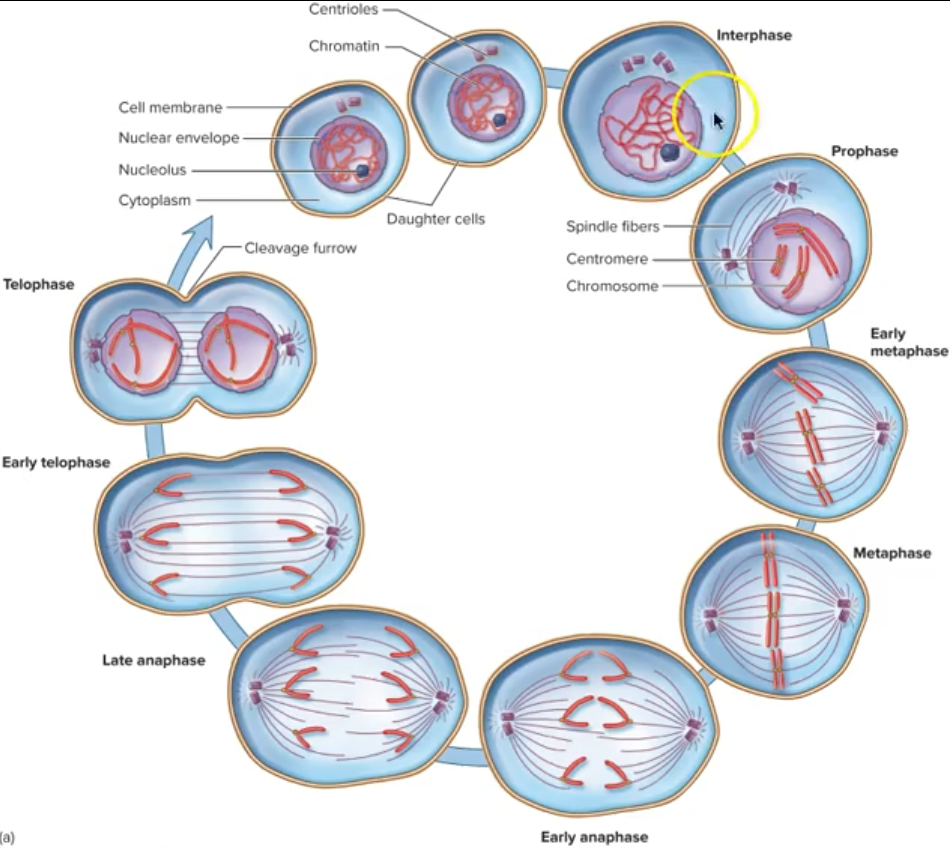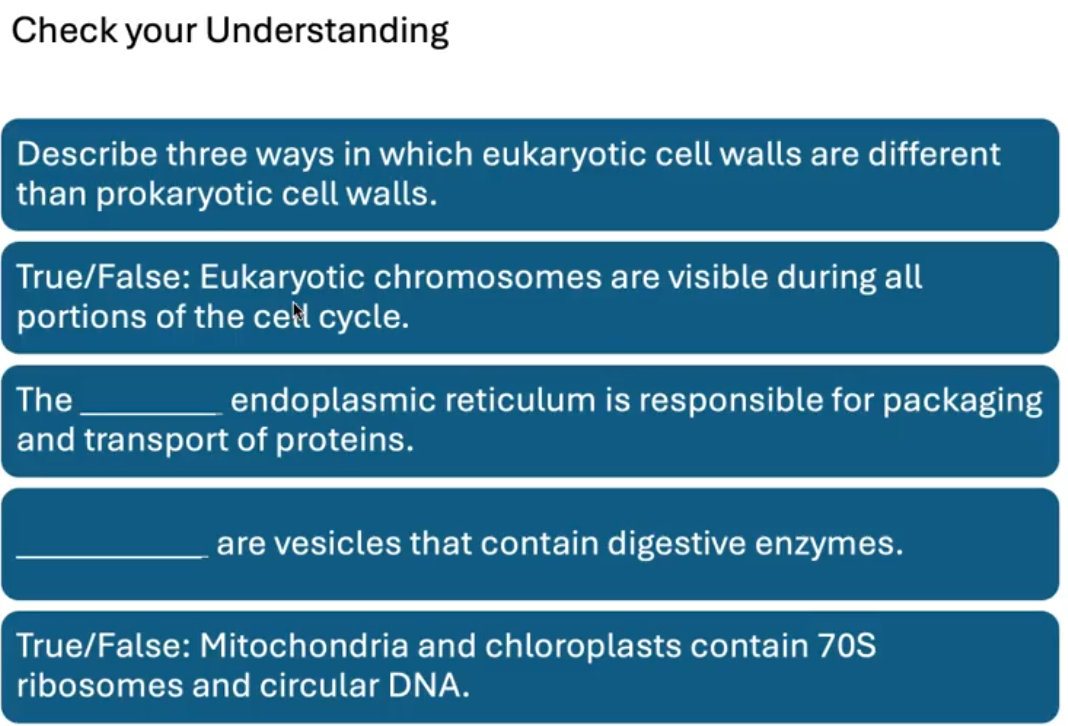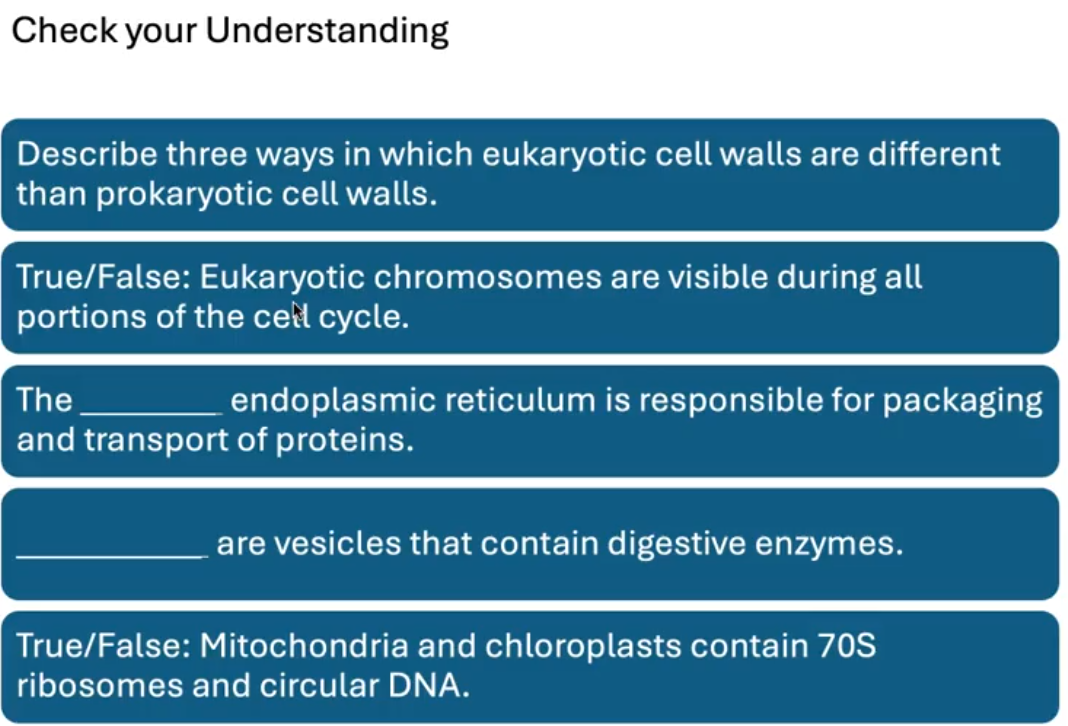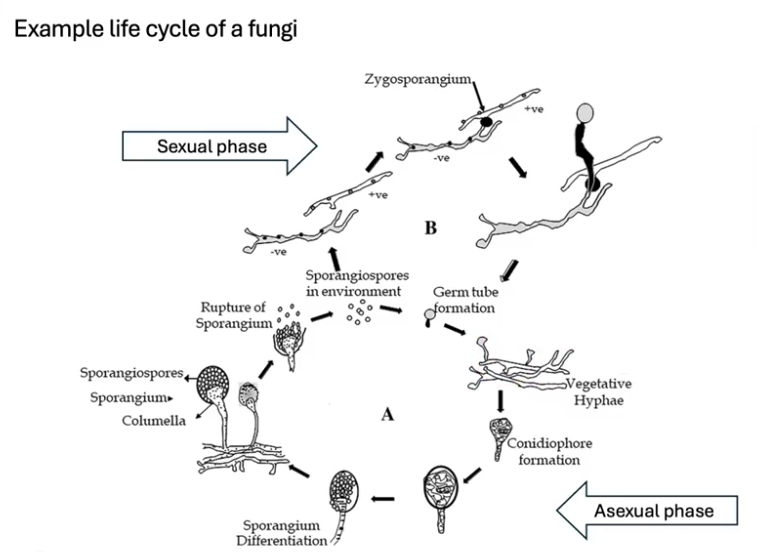Chapter 5 SG (go to flashcard)
1/119
Earn XP
Description and Tags
lecture and textbook
Name | Mastery | Learn | Test | Matching | Spaced |
|---|
No study sessions yet.
120 Terms
Relate bacterial, archaeal, and eukaryotic cells to the last common ancestor
ALL 3 cells evolved from a different cell, precursor to prokaryotes/eukaryotes that biologist call the last common ancestor.
Ancestor was neither prokaryotic nor eukaryotic, but gave rise to all three types
List the types of eukaryotic microorganisms and say which are unicellular and which are multicellular.
Protozoa: Always unicellular
Fungi/Algae: May be unicellular or Multicellular
worms are multi but their egg are uni
Explain how endosymbiosis contributed to the development of eukaryotic cells.
Endosymbiosis: Relationship where a microorganism resides within a host cell and gives benefit to host cell
The large and small cells formed a symbiotic relationship where BOTH cells benefited. Some small cells were able to break down the large cell's wastes for energy.
Differentiate among the flagellar structures of bacteria, archaea, and eukaryotes.
Eukaryotic Flagellum- is 10x thicker, complex structure, covered by cell membrane extension, microtubules in 9×2 formation
Prokaryotic- moved in a propeller type fashion; Flagella are for moving to get them to nutrient and away from harm
Describe the important characteristics of a glycocalyx in eukaryotes.
composed of polysaccharides
appears as a network of fibers, a slime layer, or a capsule.
It provides protection and adherence of cells to surfaces.
List which eukaryotic microorganisms might have a cell wall.
fungi, algae
List similarities and differences between eukaryotic and bacterial cytoplasmic membranes.
Eukaryotic cell membranes contain sterols of various kinds, Sterols rigidity makes membranes more stable.
BOTH: Typical bilayer of phospholipids w/embedded protein molecules
Describe the main structural components of a nucleus
nuclear envelope: composed of 2 parallel membranes
Pores: formed by the connection of the inner and outer nuclear membranes
nucleolus: stains more intensely than the immediate surroundings because of its RNA content (RIBOSOMAL synthesis site)
chromatin: feature of the nucleoplasm in stained preparation is a network of dark fibers known as chromatin
How do the nucleus, endoplasmic reticulum, and Golgi apparatus act together with vesicles during the transport process.
-like an assembly line
-a segment of genetic code of DNA containing instructions for producing a protein is copied into RNA and passed out of the nuclear pores to the ribosomes on the RER.
-proteins are synthesized from rNA code and deposited into RER.
-protein products are transported to the Golgi apparatus into vesicles that can be used by the cell
-come of the vesicles contain enzymes to digest food, others are secreted to digest materials outside the cell,
Explain the function of the mitochondrion
generating ATP, metabolism “powerhouse of the cell”
hold the enzymes and electron carries of aerobic respiration
-extracts chemical energy contained in nutrient molecules and stores it as ATP
Explain the importance of ribosomes and differentiate between eukaryotic and bacterial types
-Eukaryote: Ribosomes synthesize all the protein
-Bacterial: -Can be found in short chains of polyribosomes
-Staging areas for protein synthesis
List and describe the three main fibers of the cytoskeleton.
-actin filaments: long thin protein strands . are most highly concentrated just inside the cell membrane. Responsible for contraction, crawling, pinching during cell division, and formation of cellular extensions
- intermediate filaments: ropelike structures. They are the structural reinforcement to cell and organelles. support structure of the nuclear envelope
-microtubules: long and hollow tubes that maintain the shape of eukaryotic cells with no cell wall, and they transport substances from one part of the cell to another
List three general features of fungal anatomy
ribosomes, mitochondria, a cell wall and cell membrane, a nucleus
Differentiate among the terms heterotroph, saprobe, and parasite
heterotroph- organism that gains their nutrients from organic materials.
saprobe- organism that acquires their nutrients from dead and decayed organisms. Moreover, they dwell in bottoms of the soil and water.
Parasite is an organism that actually lives on a living organism.
Explain the relationship between fungal hyphae and the production of a mycelium
A simpler answer: mycelium is the vegetative body of a fungus, constructed from a mass of interwoven hyphae
Describe two ways in which fungal spores are formed.
Asexual Spore Formation:
In this method, spores are produced by mitosis, meaning the offspring are genetically identical to the parent.
Sexual Spore Formation:
Sexual spores are produced through meiosis after the fusion of two compatible nuclei
List two detrimental and two beneficial activities of fungi (from the viewpoint of humans).
Detrimental: causing diseases and food spoilage;
Beneficial: used in antibiotics (like penicillin) and fermentation.
Note the protozoan characteristics that illustrate why they are informally placed into a single group.
Protozoa are single-celled eukaryotes (organisms whose cells have nuclei) that commonly show characteristics usually associated with animals, most notably mobility and heterotrophy
List three ways of locomotion exhibited by protozoa.
flagellar movement, ciliary movement, or amoeboid movement.
Explain why a cyst stage may be useful in a protozoan.
It helps to survive in adverse conditions.
The unfavorable conditions are like high temperature, scarcity of food, lack of oxygen, lack of moisture, and presence of toxic chemicals.
Give an example of a human disease caused by each of the four types of protozoa
1. Amoeboid protozoa: Entamoeba histolytica causes amoebiasis
2. Ciliated protozoa: Balantidium coli causes balantidiosis
3. Flagellated protozoa: Giardia lamblia causes giardiasis which develops intestinal distress. This disease spreads by contaminated water and food.
4. Nonmotile protozoa: Plasmodium vivax of this class causes malaria in humans.
List the two major groups of helminths and provide examples representing each body type.
Platyhelminthes or flatworms consist of blood fluke, pork tapeworm etc.
Nematodes or roundworms consist of ascaris, ex. guinea worm, trichina worm, pin worm etc.
Summarize the stages of a typical helminth life cycle.
Must transmit and infective form (egg or larva) to the body of another host
Host in which the larva develops is known as the intermediate host
Adult hood and mating occur in the definitive host
Sources for human infection include food, soil and water and infected animals
1st Eukaryotes showed up on Earth How many years ago?
4 billion (textbook says 2-3 billion)
What is the name of the precursor that bacteria and eukaryotes evolved from? (neither were prokaryotes/eukaryotes)
last common ancestor (LCA)
this gave rise to eukaryote, bacteria/archaea separately
Where did organelles originate from?
originated from more primitive cells that were trapped in eukaryotic cell
TRUE/FALSE: 1ST Primitive eukaryotes were single celled and independent that were specialized to perform a function in colony.
True
Complex, multicellular organism evolved when cells lost….
the ability the survive away from the colony (tissues/organs)
Features found in ALL EUKARYOTIC CELLS
Cytoplasmic membrane, cytoskeleton, endoplasmic reticulum, Golgi apparatus, glycocalyx, mitochondria, nucleus, vacuoles
Features found in CELLS OF SOME EUKARYOTIC GROUPS
cell wall, locomotor appendages, chloroplasts
Eukaryotic flagella vs. Bacteria flagella (the answer will only pertain to eukaryotic)
10x thicker. complex structure
covered by a cell membrane extension
long sheathed cylinder with hollow microtubules in 9+2 arrangement
whipping motion in locomotion
Cilia (Eukaryote cells)
similar structure to flagella, shorter and numerous hair like
found in a single protozoa group and certain animal cells
function as feeding/filtering structures on some cells
Moves in an oarlike rowing motion
The Glycocalyx
outermost boundary comes into direct contact with the environment
“extracellular matrix”
composed of polysaccharides
role in cell recognition/protection
The Cell Wall
found in fungi/algae
rigid and provides structural support/shape
different chemical composition than bacterial cell wall
Chitin or cellulose is structural support for…?
fungi
The Cytoplasmic Membrane
bilayer of phospholipids embedded with protein molecules
(has its own glycoprotein to relay information)
stabilizes eukaryotic membranes
The Nucleus
a compact sphere
separated from the cytoplasm by the nuclear envelope
The NUCLEOLUS is here
stains more intensely due to RNA content
site for ribosomal RNA synthesis
Mitosis and Meiosis are the _____ __ ______ ____ within eukaryotic cells.
copying of genetic material
Eukaryotes keep their genetic material in the form of chromosomes. What is the name of the material that makes up the eukaryotic chromosomes?
chromatin
Chromatin
contains units of genetic information in the cell
long linear DNA molecules bound to histone proteins (loose)
visible in meiosis
Meiosis
(production of sex cells)
Mitosis Phases
Interphase, Prophase, Metaphase, Anaphase, Telophase

Early Prophase
Chromatin condenses to form visible chromosomes.
Each chromosomes and sister chromatids are held together by a centromere.
Centrosome and its’s duplicated start synthesizing microtubules that push centrosome to mitotic spindle.
Asters (microtubules) radiate from centrosome
Late Prophase:
Nuclear envelope breaks apart
microtubules attach to an area on centromeres called kinetochore and pull chromosomes to the equator of cell
Remaining kinetochore push against each other, making the cell poles to move farther apart
Metaphase
Centromeres of chromosomes are precisely aligned at the cell equator
The imaginary plane midway between the poles is called metaphase plate
Anaphase (shortest phase)
centromeres of chromosomes split at the same time
sister chromatids——→separate chromosomes
chromosomes are pulled to their respective poles by motor protein of kinetochores (one chromosome of each original pair goes opposite poles)
non-kinetochores microtubules keep forcing poles apart
Telophase- begins when chromosome movement stops
each set of chromosomes at opposite ends of cell will uncoil to form chromatin
nuclear membrane form around each chromatin mass
nucleoli reappear, spindle disappears
Endoplasmic Reticulum
microscopic series of tunnels used in transport and storage
Rough Endoplasmic Reticulum (RER)
ribosomes attached on surface
proteins held for packing and transport
Smooth Endoplasmic Reticulum
no ribosomes
synthesis and storage of non protein molcules
Golgi Apparatus
site of protein modification/transport
consists of a stack of flattened, disc-shaped sac
closely connected to endoplasmic reticulum (er)
Where it is close to the Golgi apparatus, ER forms _______ ______ that golgi apparatus picks up
transitional vesicles
Golgi apparatus adds ______ and lipids to proteins in transitional vesicles and pinches off _______ ____
polysaccharides, condensing vesicles
(then it is conveyed to lysosomes or transported to secretory vesicles)
cellular vesicle: LYSOSOME
originate from golgi apparatus, has a variety of enzymes
involved in intracellular digestion of food
protection against invading microorganisms
cellular vesicle: VACUOLES
membrane bound sac
has fluids or solid particles to be digressed, excreted, or stored
The origin of organelles (like mitochondria/chloroplast) is believed to be due to bacterial or archaeal cells ______ another descendant cell of LCA and then becoming a ________ part of that cell
parasitizing, permanent
Endosymbiosis could explain why mitochondria and chloroplasts have (3 things)
own circular DNA
70S ribosomes
own two-layer membranes
Mitochondria AKA THE POWERHOUSE OF THE CELL
(energy generator of the cell)
supply the bulk of energy of a cell
divide independently of the cell
circular strands of DNA
bacteria sized 70S ribosomes
Mitochondria structure:
Cristae: folds on inner membrane that hold enzymes and electron carriers of aerobic respiration
Matrix: holds ribosomes, DNA, and enzymes, and compounds used in metabolism
Chloroplasts: Photosynthesis Machines
turn sunlight energy into chemical energy by photosynthesis
role: main producers of all organic nutrients and oxygen gas
Ribosomes: Protein synthesizers
all throughout cell, scattered freely in cytoplasm/cytoskeleton, attached to RER
inside mitochondria/chloroplasts
arranged in polyribosomes (short chains of ribosome)
How are eukaryotic ribosomes similar to bacterial ribosomes in structure:
They have large and small subunits of ribo-nucleo-protein
The full size of ribosome is 80S (60s+40s subunits)
Cytoskeleton
functions: anchoring organelles, moving RNA and vesicles, allowing shape changes and movement
3 main types: actin filaments, intermediate filaments, microtubules (structure support)

look at this
look at this

Fungi
3-4 million species of fungi divided into 2 groups:
macroscopic fungi: mushrooms, puffballs, gill fungi
microscopic: molds, yeasts
Morphology of yeast cell
round to oval shape
uses asexual reproduction (yeast makes bacteria look tiny as shit)
Morphology of Hyphae
long, threadlike cells found in filamentous fungi or molds
Pseudo hypha: chain of yeast
Morphology of Dimorphic fungi
In cold environments, such as soils, these fungi appear as multicellular molds that are connected to a network of mycelium.
In the warm environment of a hosts body, they take on a single-celled yeast morphology.
Fungal Nutrition (fungi tend to be saprobes)
Heterotrophic: acquire nutrients from wide variety of substrates
Saprobes: obtain substrates from dead plants and animals (few can photosynthesize)
Parasites: live on the bodies of living animals or plants
Microscopic Fungi-grow loose in associations or colonies, 3 parts
Mycelium: the woven , intertwining mass of hyphae that makes up the body or colony of a mold
Septa: cross walls dividing hyphae into segments
Spore: fungal reproductive bodies
What are the functional types of Hyphae using the mold Rhizopus as an example?
Type of Hyphae | Function |
|---|---|
Rhizoids | Anchoring & nutrient absorption |
Stolons | Surface spread & connection |
Sporangiophores | Asexual reproduction |
Fungi have many complex and _____
successful reproductive strategies
Fungi have a simple _____ _____ of existing hyphae
outward growth
Fragmentation (reproduction of fungi)
is a separated piece of mycelium can generate a whole new colony
Primary reproductive mode (reproduction of fungi)
spore formation
Fungal spores should not be confused with the more_______
nonreproductive bacterial endospores
Fungal spores are
reproductive
The two types of asexual spore formation
sporangiospores: formed by successive cleavages within a sporangium
conidiospores/conidia: free spores not enclosed by a spore-bearing sac
purpose of sexual spore:
The main role is dispersal and genetic recombination.
Because important variations occur when fungi of different genetic makeup combine their genetic material
slight variations in the form/function are potentially advantageous to the adaption and survival of the species
Note: in the lecture she said we will spend VERY little time on plant and fungal genetic. cause it’s so fucking complicated
okay!

Heres an example of fungi life cycle (don’t worry so much about it)
okay!
Most human fungal infection occurs through accidental contact with
soil, water, or dust
Infectious/ Pathogenic Fungi are casued by
Community acquired infections caused by environmental pathogens
hospital-associated infections caused by fungal pathogens in clinical settings
Opportunistic infections caused by pathogens infecting already weakened people with a
transplant, cancer, and HIV+
Medical Conditions caused by Fungi
candidiasis
tinea vesivolor
ringworm (tinea corporis)
histoplasmosis
fungi are also involved in other medical conditions besides infections
allergies and neurological conditions due to toxin production
Beneficial impacts of fungi
role in decomposing organic matter and returning essential minerals to soil
form stable associations with plant roots that increase water/nutrient absorption
production of antibiotics, alcohol, organic acids, vitamins
flood flavoring
alcohol in beer wine, gas that causes bread to rise
Algae and protozoa have been traditionally combined into the KINGDOM Protista and these two subdivisions:
Subkingdom algae
subkingdom protoza
What is a protist?
any eukaryotic unicellular or colonial organism that lacks true tissues
What is algae? (photosynthetic protists)
group of photosynthetic organisms, widespread inhabitants of fresh and marine water
Plankton?
floating community of microscopic organisms, essential role in aquatic food web, produce 70% if earth’s oxygen
Primary medical threat from algae, is through ingestion of toxins during a
red tide
Protozoa include about ______ species
65,000
The predominant habitats for protozoa are:
fresh and marine water
soil
plants
animals
While most members are harmless, a few species are ______ responsible for hundreds of millions of infections in humans per year.
parasites
Protozoan Form: they are single cells containing all major eukaryotic organelles BESIDES
chloroplasts
Protozoan Organelles can be highly specialized into structure similar to:
mouth
digestive systems, reproductive tracts
legs-in means of locomotion
Protozoan Nutrition
heterotrophic and require their food in complex organic form
Protozoan free-living species nutrition
scavenge dead plant or animal debris
graze on live cells of bacteria and algae
Protozoan parasitic species nutrition:
live in fluids of the host such as plasma and digestive juices
may actively feed on tissues